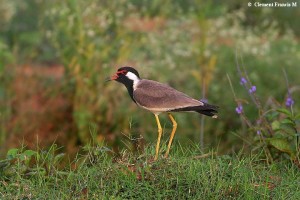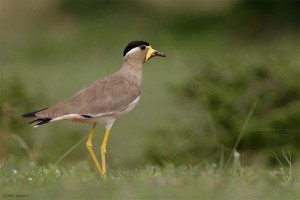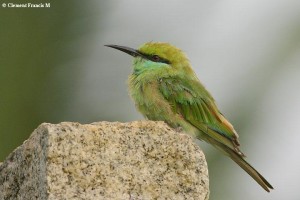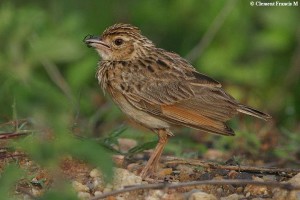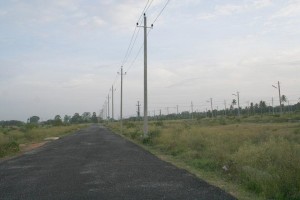
There was so much news on Arkavathy Layout in Bangalore outskirts, one of the largest residential site plans that BDA (Bangalore Development Authority) took up and something that went wrong (let us not touch the details) and the whole project is on hold, for now. The birds that had made their home in this region for many years now are spared for the time being as the development activities have come to a standstill. We (S. Venkataraman, Suresh V and self) bird this region often as it is a good scrub and grass land with lots of dry land birds like francolins, quails, lapwings, bushchats, larks, weavers and munias. The presence of small water tanks, grasslands and thorn bushes along with a bit of rocky terrain has created a perfect home for these birds.
In this bulletin, you will see the pictures that we made in this region in the last few months and also how another bird haven is to be lost to ‘development’ and expansion of Bangalore City.
Grey Francolins, Yellow Wattled and Red Wattled Lapwings:
The land is covered in grass and plenty of termite mounds. The grass seeds and termites form the staple food of the Francolins and also the fields are filled with locusts, moths, caterpillars and other insects which attract the lapwings in good numbers. The yellow wattled lapwings are seen here in good numbers and if one is lucky some day even a group of around 15 can be spotted. They are breeding residents here. Also the red wattled lapwings breed here but the yellow wattled lapwings dominate them with their numbers. We were lucky to see one red wattled lapwing herding its young among the shrubs and bushes. Even the Grey Francolins can be seen here with their young in tow.
Pied Cuckoo, Silverbills, Bushchats, Bee-eaters, Larks & Pipits:
The presence of acacia trees, lantana and thorn bushes attract this monsoon migrant “The Pied Cuckoo”. They were seen hunting for the juicy caterpillars and moths. The pied bushchats breed here very successfully. Their nests are fully fledged young out there.
The Indian Silverbills are in good numbers here. They are seen here always in groups feeding on the grass seeds, parthenium blossoms and lantana. Their life style of group living, playing, preening & quarrelling with each love with these tiny beauties.
As for the larks, the Jerdon’s Bushlark is a breeding resident. The Rufus-tailed lark also can be seen here. The Paddyfield Pipits are in good numbers and are breeding residents too.
The ever growing Bangalore City is just consuming good bird habitats around one after the other. Industrialization has a stronghold in this Garden City and I don’t know how long this will go on and the ultimate silent sufferers are the local wildlife that get evicted from the land they had made their home for long years, much before Information Technology and Population poured into Bangalore.
Watching Baya Weavers – Ramapura village, North Bangalore – Suresh V
Roughly 10 kilometers north of Bangalore is a small sleepy village called Ramapura. The village abuts a huge lake which is also called ‘Ramapurakere’. Clement has long birded in this area and has recorded Red Necked Falcons and Baillon’s Crakes breeding in the region. However that was long ago and today one doesn’t see these rare species here anymore. A fast expanding city so close with high levels of air, water pollution could surely be the cause. And the village itself is caught unawares today with Bangalore almost next to it and surrounded by residential layouts.
On the outskirts of the village and just opposite to the lake is a small eucalyptus grove, adjacent to which is a small stunted tree adjoining a ground level well. This tree is used by several pairs of Baya Weavers to nest and breed, year after year as the monsoon sets in South India. The grove is home to a pair of spotted owlets that we always see on our visits, and the well is used by a common kingfisher for its day time feeds.
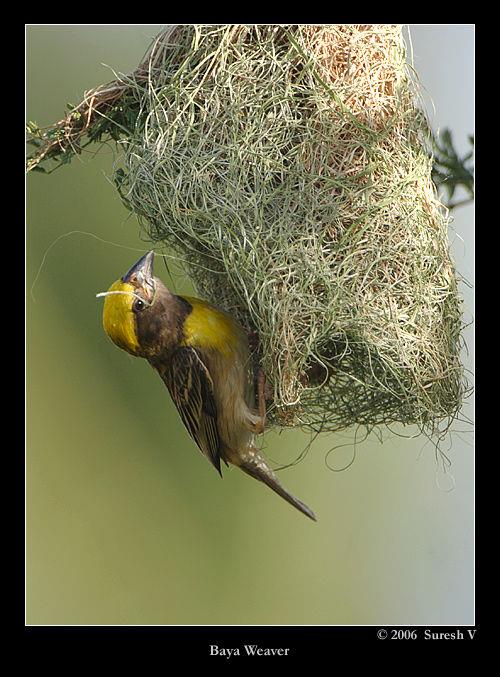
Baya Weavers are very interesting birds to watch. The males start repairing and building their nests as the monsoon starts setting in. Each male will have multiple nests, and during the nest building activities there would be much noise and fighting between the males while they try to defend their nests from other males. A female would now and then make a fleeting visit to inspect the nests. The female will mate with the builder of the nest which it likes most. Male Baya Weavers practice polygamy in that they will mate with more than one female. Before the nesting season starts and after the nesting season is over it is not often that we see the Baya Weavers at this place. For us ordinary humans it is a deep mystery as to where they go during these times.
When you have an evening to spare, do visit this place and spend some time watching these master weavers in action. Their nest building skills are something we can watch in awe. However the place is very disturbed with the lake having been polluted much, garbage being dumped in huge mounds near the lake, and several residential colonies coming up in the area means the weavers might disappear any year now for good from this place. So much for ‘development’.



